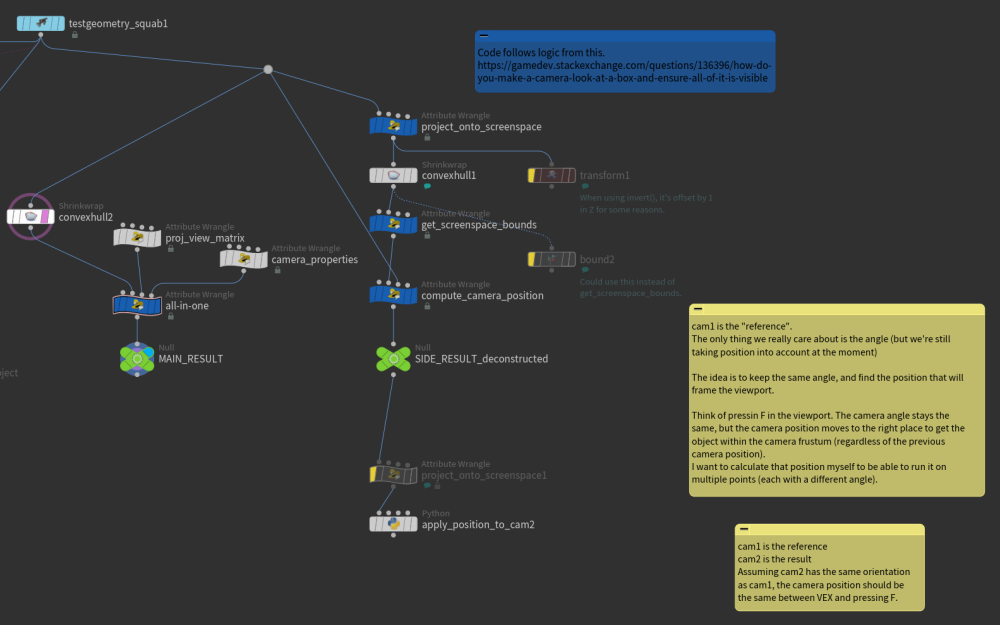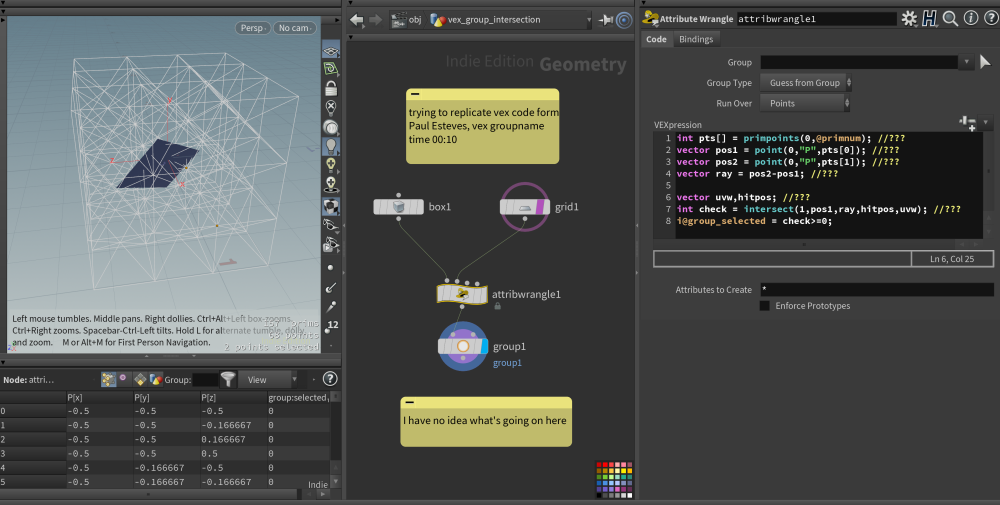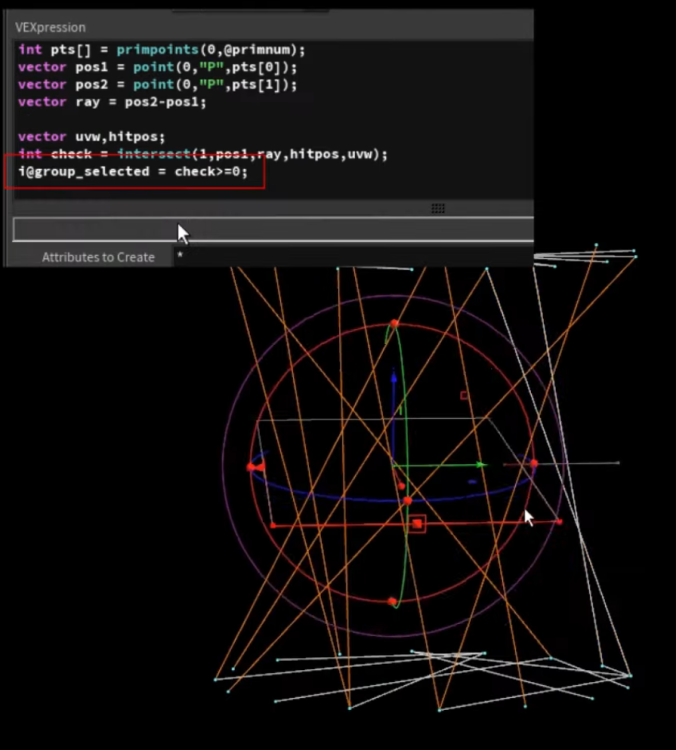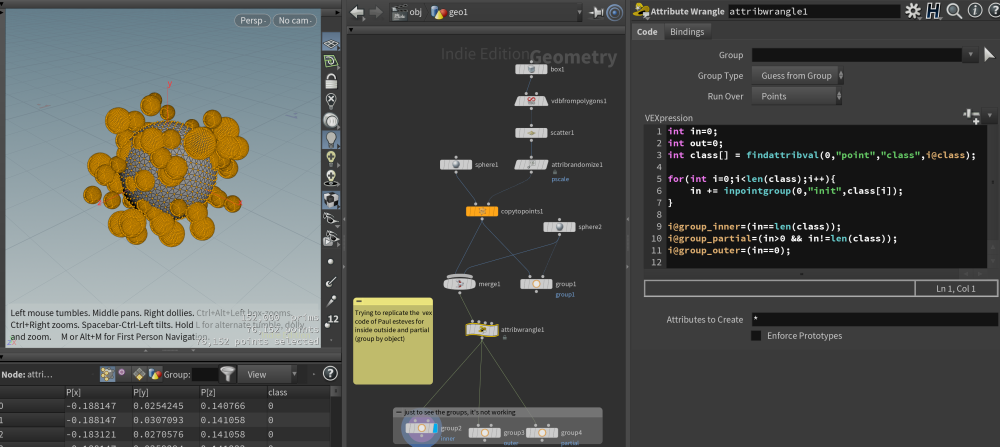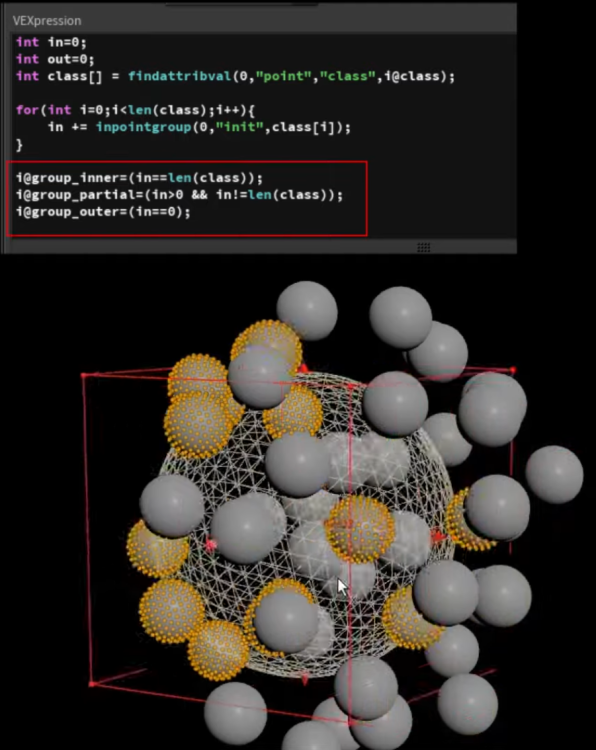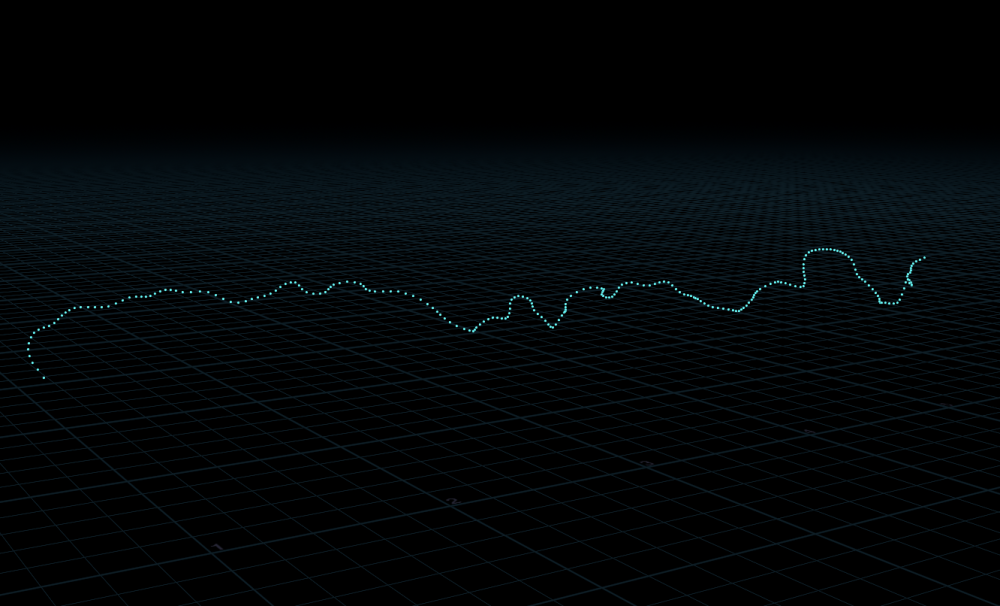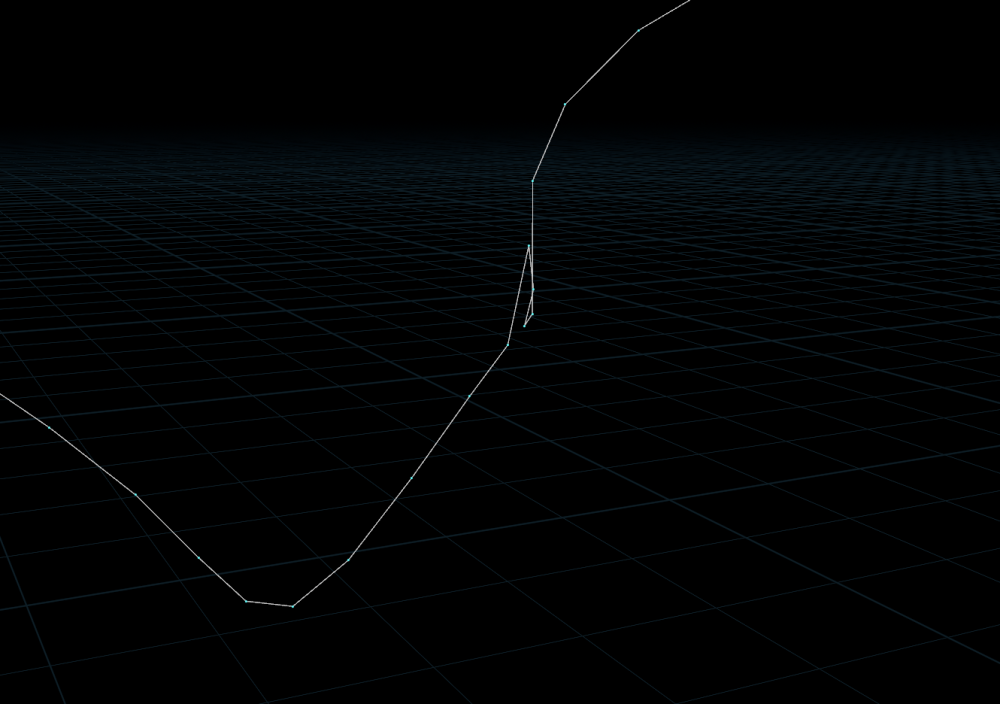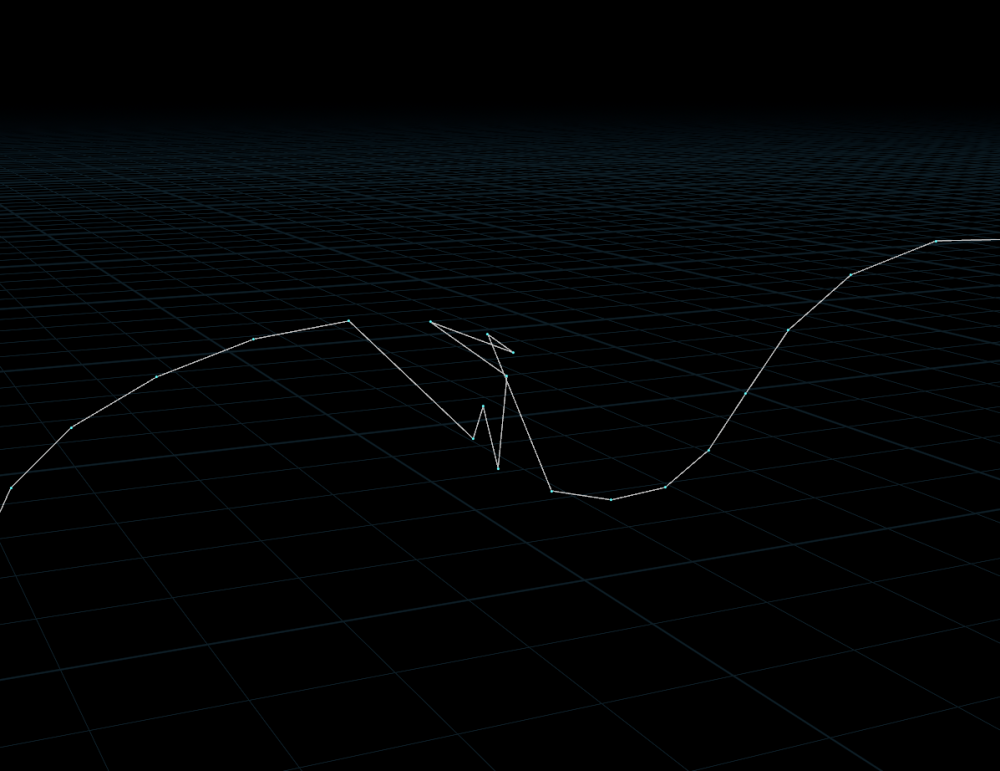Search the Community
Showing results for tags 'VEX'.
-
A noob grains upres question here… I created a massive fracturing grains sim with Vellum at a low-ish resolution, and I'm using the grains' velocities to drive smaller dumber particles. When using the POP Advect by Volume, the particles are pushed around correctly as expected, but when they exist the Velocity field they slow down dramatically almost to a halt. This is because I am using "Treat as Wind" with very high "Air Resistance" values, to counteract the Gravity force. How can I sample the Density of the same volume, and use that to influence the "Air Resistance"? This way the core of the volume will stick to the Velocity, and as we get further away from the core, the Velocity will have less and less influence, with gravity taking over... I spent hours on this yesterday, trying to find a way to bring the volume Density into the DOPNet as a sort of falloff for the POP Advect by Volume node… I even tried transferring the volume density to the Grain source points in SOPs as a float value, hoping I could hook strength data out of them that way, but again, just not luck at all! I’m aware this must be incredibly simple to do, but I just cannot figure it out at all. There doesn’t seem to be any kind of masking options available in the nodes I’m using. One kind Facebook user on the Houdini Artists group told me this VEXpression could be pasted into the POP Advect by Volume node: @airresistance *= fit(length(volumevelocity), 0, value, 0, 1); value = the speed value where you want the resistance to be full. However, this is not referencing density, and so far, isn't working anyway - but I get the idea.... Can anyone advise on the best steps to do this?
-
I'm trying to create a Vector parameter using VEX on an Attribute Wrangle. None of the channel functions, including chv() seem to work. Does anyone know why?
-
I'm leaving this file here in case you want to sort the point order of a triangle sphere. Its not particularly usefull but I was tasked with that challange and thats what I came up with... Hope it helps, and if any of you has a better method feel free to share! sorting_a_triangle_sphere.hip
-
- triang sphere
- point sort
-
(and 3 more)
Tagged with:
-
-
These are some basic ideas that I used when creating the Saliva for movies like Hellboy (2019) and Manikarnika: Queen of Jhansi (2019). The main goal was to be able to Art Direct everything anytime as there were over 14 shots where the Supervisor and Director had very specific notes. Visit my blog for more articles on Houdini Blog: https://sharanvaswani93.wixsite.com/s... Email: sharan.vaswani93@gmail.com
-
Getting closer to a new surreal idea I had in mind for a long time...Walls with Eyes! Here is my initial test for a small section of the wall. hoping to add in more detail and deformations to the rig the wall skin rig. I made the entire model and rig process combined into a single HDA. May need to optimize the HDA further to speed up things. Instead of using deformers to the bend the grids I started off with using curves and a combination of ray intersects and vex to create the eyelids, after creating the initial shape I was able to skin the curves using the Skin SOP, this gave me more control on how I can design the character, without worrying about intersection polygons and normals. The curves also acted as representatives for each loop on the wall and so I was able to control them in wrangles through multiple technics in vex.
-
LookAt Setup in SOPs, VEX, VOPs. Having used the Houdini default tools several times, I wanted to achieve the same effect in SOPs. Here is a detailed post to understand better how the LookAt works and how it can be used in creative ways https://www.sharanvaswani.com/single-post/2020/09/27/Using-VEX-and-SOPs-to-make-a-LookAt-Setup
-
Want to have multiple explosions in your shot? Let's populate them! Why go through the trouble of simulating each Fx when we can just populate a scene with a few! The Populate Toolset is a comprehensive HDA (Houdini Digital Asset) Toolkit designed for intricate control to populate a scene with various caches. The OTL uses a bundle system, so we can switch between a low-resolution proxy cache and a high-resolution render cache anytime. This makes it easy for artists to preview shots, layout simulations and art direct timing as per their needs. How does this Setup Help? Easy Layout: Create quick and easy layouts and previews for your shots without using high config machines and dealing with the laggy viewport. Quick Controls: Get quick controls to art direct your simulation like adjusting scales, rotation and timing. Randomizer: An easy randomizer to get started with. Override Tool: When you need small adjustments just use the override tool to fix it! Gizmos: Gets user friendly preview gizmos that help artists preview scales and placements of cache. Used on Beautiful Hunan: Flight of The Pheonix & Halo (Mini TV Series) Get the HDA and Files on Gumroad: https://chakshuvfx.gumroad.com/l/art-direct-instances
-
Houdini FFX Collection Get it here: Gumroad: https://davidtorno.gumroad.com/l/ffxcollection FFX Collection is a collection of scene builds and techniques for the intermediate users of Houdini. Those looking for quick setups, wanting to get more familiar with VEX use cases, and wanting to get started in Karma and Material X. This collection of “presets” as it were showcases a variety of topics within Houdini. Builds include FLIP, RBD, Vellum, POP, Pyro Solver, SOPs, LOPs, TOPs, Karma, and Material X. All renders use 100% fully procedurally generated textures created with Material X noises. The only exceptions are the test geometry textures which are directly read from their HDA embeded jpg textures. The HDA is a simple drop down list of all fifty builds, of which you choose the one you want and click “Build It” to have the tool generate the entire build for you. By default there is Network box organization to help understand the flow and processes that are occuring. Additionally there are annotated tips, and helpful explainer sticky notes to help inform an techniques used. These annotations are also optional and can be turned off before building the network. For those wanting to dive straight into everything there is to offer, there is a “Build All” button to create all 50 builds. This option will have each build turned off by default, so as to not overload your machine with too many items trying to cook. All builds involve various techniques and useful information. Each “category” is defined by the primary method used for the solution used. Be that by SOP nodes directly, VEX code, VOPs network, or even by simulation type like Vellum, Flip, RBD, or Pyro. Vellum does have a few builds under the VEX category as well. Builds include: FLIP Attraction To Curve Shape FLIP Fill Solid Object FLIP Melt Object FLIP Object Surface Advoidance ForEach Incriment Point Count Per Curve ForEach Poly Reduce Pieces By Volume Attrib ForEach Stacking Random Cubes PyroSolver Geometry Ripples PyroSolver Pyro Color Change Over Time PyroSolver Pyro Color From Texture RBD Activate Pieces RBD Apply Proxy Sim To HiRes Source RBD Attraction To Curve Shape RBD SOP Emit Every X Frames RBD V W Constrained Axis SOPs 8Bit SOPs Cull Random Curve Segments SOPs Dissolve Curve SOPs Dissolve Geo SOPs Echo Curve SOPs Post Shrink RBD Pieces Over Time SOPs Stone Path Vellum Animate Restscale Via Attrib Vellum Basic Fluid Cloth Two Way Coupling Vellum Cloth Flows Along Curve Vellum Define Cloth Ripping Vellum Flag In Wind Vellum Inject Geo Over Time Vellum Paper Whirlwind Vellum Spheres Expanding In Box VEX Blend Mask VEX Cull Back Faces VEX Custom Guides For Vellum Hairs VEX Falloff Radius Around Curve VEX Geo Look At Target VEX Geometry Ripples VEX Guided Infection VEX Per Poly Transform Via Particle Proximity VEX Per Prim Rotation Around Edge VEX Repeat Ramp Values VEX Ring Waves With Falloff VEX Rotating Grid Tiles VEX Sin Cos VEX Sliding Points Along Curve VEX Vellum Dangling Cables VEX Vellum Sim Forces From SOPs VEX Vellum Source Emission Instancing VEX Voronoi Fracture Animated VOP Blend Mask VOP Orientation Along Curve
-
After more than 5 months of unimaginable amount of work, I am proud to release my first in-depth Houdini course on VEX More details in the video description and the website. Active Patreon members will receive additional discounts proportional to their lifetime support (25% of their lifetime support). Message me on Patreon for your discount coupon. Enjoy! 01 - Introduction [Point Clouds] 02 - Introduction [pcopen() vs pcfind() vs nearpoints()] 03 - Introduction 04 - Implementation 05 - pcfilter() Implementation for pcfind() 06 - pgfind() 07 - pcfind_radius() 08 - Excluding the Current Point & Ad-Hoc Groups 09 - Finding Min & Max Neighbour Points [Unique Pair Matching] 10 - Concept 11 - Implementation [Camera Based Occlusion with Variable Pscale] 12 - Concept 13 - Implementation [Uniform Point Distribution Over Polygonal Surfaces [Point Relaxation]] 14 - Concept 15 - Implementation 16 - Decoupling Operators [Convolution Kernels] 17 - Introduction 18 - Border Handling [Connectivity & k-Depth Point Neighbours Using Edges] 19 - Introduction 20 - Concept 21 - Implementation [Connectivity & k-Depth Point Neighbours Using Primitives] 22 - Concept 23 - Implementation [Extending k-Depth Point Neighbours Using Edges] 24 - Introduction 25 - Concept 26 - Implementation [Extending k-Depth Point Neighbours Using Primitives] 27 - Concept 28 - Implementation [smoothstep() [Cubic Hermite Interpolation]] 29 - Concept 30 - Implementation [Shaping Functions] 31 - Introduction 32 - Implementation 33 - Blurring Attributes [Sharpening Attributes Using Unsharp Mask] 34 - Concept 35 - Implementation [Generalizing the Kernel Code to Handle All Attribute Types] 36 - Concept 37 - Implementation [Attribute Gradient] 38 - Introduction 39 - Concept 40 - Implementation [Gradient Ascent & Descent] 41 - Planar Geometry - Introduction 42 - Planar Geometry - Concept 43 - Planar Geometry - Implementation 44 - 3D Geometry [Contour Lines] 45 - Introduction 46 - Concept 47 - Implementation 48 - Heightfields [Geometric Advection - Orthogonalization & Flowlines] 49 - Introduction 50 - Concept 51 - Implementation [Clustering & Quadtrees] 52 - Concept 53 - Implementation [Adaptive Subdivision] 54 - Introduction 55 - Implementation 56 - Hashing [Adaptive Subdivision] 57 - Improving OpenSubdiv Catmull-Clark Subdivision Surfaces Algorithm 58 - Half-Edges [Adaptive Subdivision] [Aggressive Performance Optimizations] 59 - Eliminating Groups 60 - Custom Fusing In VEX 61 - Recreating Proximity Structures In VEX 62 - Get Unshared Edges In VEX 63 - Final Optimizations [Limit Surface Sampling] 64 - Introduction 65 - OpenSubdiv Patches 66 - Moving Points to the Subdivision Limit Surface 67 - Scattering Points on the Subdivision Limit Surface 68 - Generating a Point Cloud on the Subdivision Limit Surface 69 - Pre-Generating a Point Cloud on the Subdivision Limit Surface 70 - Creating Isolines on the Subdivision Limit Surface [Adaptive Subdivision] 71 - Computing Surface Normals from the Subdivision Limit Surface [Custom Subdivision Surfaces] [Splitting Edges [Edge Divide]] 72 - Concept 73 - Converting Edges to Primitives 74 - Creating New Edge Points [Rebuilding Polygons] 75 - Concept 76 - Implementation 77 - Preserving & Interpolating Attributes 78 - Multithreading by Connectivity 79 - C++ vs VEX 80 - Preserving Groups 81 - Final Optimizations [Implementing Bilinear Subdivision] 82 - Introduction 83 - Concept 84 - Modeling Test Geometry 85 - Starting from Edge Divide 86 - Creating New Face Points 87 - Creating New Edge Points [Creating New Closed Polygons] 88 - Concept 89 - Implementation [Creating New Open Polygons] 90 - Concept 91 - Implementation 92 - Preserving Primitive Groups & Interpolating Primitive Attributes [Preserving Vertex Groups & Interpolating Vertex Attributes for Closed Polygons] 93 - Concept 94 - Implementation 95 - Preserving Vertex Groups & Interpolating Vertex Attributes for Open Polygons 96 - Implementing Iterations 97 - Preserving Literal Groups 98 - Creating Neighbour Primitives 99 - Final Changes 100 - Testing On Complex Geometry [Implementing Catmull-Clark Subdivision] 101 - Introduction [Closed Surfaces] 102 - Rules [Gathering Edge & Face Points] 103 - Concept 104 - Implementation [Computing Weights for New Edge Points] 105 - Concept 106 - Implementation [Computing Weights for Original Points] 107 - Concept 108 - Implementation [Attribute Interpolation] 109 - Concept 110 - Implementation [Boundary Interpolation Rules for New Edge Points] 111 - Concept 112 - Implementation [Boundary Interpolation Rules for Original Points] 113 - Concept 114 - Implementation 115 - Open Surfaces - Handling Corner Points 116 - Handling Non-Manifold Topology [Open Polygons] [Computing Weights for Original Points] 117 - Reverse Engineering OpenSubdiv 118 - Implementation [Computing Weights for New Edge Points] 119 - Reverse Engineering OpenSubdiv 120 - Implementation 121 - Handling Open Polygonal Curves [Handling Mixed Topology] 122 - Full Geometry 123 - Sub-Geometry 124 - Testing On Complex Geometry [Performance] 125 - Profiling [Grouping Boundary Edges from Primitive Group] 126 - Concept 127 - Implementation 128 - VEX vs C++ [Caustics] 129 - Introduction 130 - Sea Caustics 131 - Pool Caustics [Enhancing Gradient Ascent, Descent & Contour Lines] 132 - Introduction 133 - Implementation 134 - Tracing Both Directions [Updating Distances Properly] 135 - Concept 136 - Implementation 137 - Looping Streamlines Problem 138 - Adding Trace Parameter [Evenly Spaced Gradient Ascent, Descent & Contour Lines] 139 - Introduction 140 - White Paper 141 - Concept 142 - Constructing the For Loop Network 143 - Improving Seed Points Selection for Tighter Packing 144 - Implementing Separation [Enforcing Separation Using Self Proximity] 145 - Concept 146 - Implementation 147 - Optimization 148 - Final Tweak 149 - Applying to 3D Geometry [Custom Subdivision Surfaces] [Extreme Performance Optimizations] 150 - Introduction 151 - Establishing Baseline for Performance 152 - Updating Attribute Interpolate Nodes 153 - Interpolation vs Copying 154 - Optimizing Input Group 155 - Caching Geometry Data 156 - pointedge vs pointhedge 157 - Getting Primitives from Half Edges 158 - Eliminating Edge Groups 159 - Parallelizing Geometry Creation for New Primitives [Unrolling Loops] 160 - Parallelizing Geometry Creation for New Edge Primitives [Unrolling Loops] 161 - Finalizing the Network 162 - Performance Profiling the Latest Version 163 - Conclusion
- 50 replies
-
- 15
-

-

-
Hi everyone, after using rhino/grasshopper, and blender for a while, I just decided to getting into houdini, so that's my quest. I would need to measure the distance between a curve and an object( the object is a pipe/tube, and a curve is an helix that goes along the tube), then copytopoints a cube with the origin on the curve going towards the tube. In order to stay procedural, I would like to give to the cube, the exact or an avarage distance between the curve and the pipe, like so I can change the radius of the 2 components (tube and curve), and the distance of the cube will follow automatically that distance
- 1 reply
-
- average
- closest point
-
(and 3 more)
Tagged with:
-
Hi guys, I'm looking to get the best way to realise this kind of pic in a realistic way.. My scene is not bad but begin to be heavy.. maybe an other way?. https://www.istockphoto.com/fr/photo/cheveux-sous-microscope-gm497686734-79258025 Thank you for help Cheveux.hip
-
Hi guys, I'm looking for the simplest way to scale a geometry, using VEX (by an attribute) and I would like to be able to define the pivot position, too. I tried these codes. It works but I don't need the other transform parts (like Position, Rotation, and ...): vector t=chv("Translate"), r=chv("Rotation"), pr=chv("pivot_rotation"); vector p = v@myPivot; vector s = f@myScale; matrix transform = maketransform(0,0,t,r,s,p,pr); @P *= transform; There is a VEX function: scale(matrix &m, vector scale_vector); But I don't know how to use it. Thanks for helping.
-
I want to control drawcurve with subnet. But I don't think I can control what's inside the subnet. I need help. I'll attach the file. subnet.hip
- 1 reply
-
- draw curve
- node
-
(and 3 more)
Tagged with:
-
Hello ! I want to be able to manually compute what the Frame shortcut does in the viewport, in VEX. I have this in Python node = hou.node("model") geo = node.geometry() bbox = geo.boundingBox() sceneViewer = hou.ui.paneTabOfType(hou.paneTabType.SceneViewer) viewport = sceneViewer.curViewport() viewport.frameBoundingBox(bbox) This frames the viewport based on an specific bounding box, but I want to calculate this for multiple view angles at once. With the python solution I would have to actually frame the viewport multiple times and record the resulting camera position each time. Attached is a scene with the tests I made after searching online. manual camera framing exploration.hiplc The main part of this scene is this code. (see the link for the reference I used) Detail Wrangle, input 1 is the geometry you want to frame (make it a convex hull), input 2 is another wrangle, input 3 is yet another wrangle (see scene for their contents). // https://gamedev.stackexchange.com/questions/136396/how-do-you-make-a-camera-look-at-a-box-and-ensure-all-of-it-is-visible // function inputs matrix proj_view = 4@opinput2_proj_view; float aspect = f@opinput3_aspect; float FOV = f@opinput3_FOV; vector camera_direction = v@opinput3_direction; // Get input points into camera space (clip space ?) vector projected_points[]; for(int i=0; i<npoints(1); i++) { vector P = point(1, "P", i); // This doesn't make sense to me, I think it should be invert(proj_view) instead P = (proj_view) * P; // addpoint(0, P); // visualize points append(projected_points, P); } // Get bounding box/rectangle/lines thing vector A1, B1, A2, B2; float width = 0, height = 0; for(int i=0; i<npoints(1)-1; i++) { for(int j=i; j<npoints(1); j++) { float new_width = abs(projected_points[i].x - projected_points[j].x); float new_height = abs(projected_points[i].y - projected_points[j].y); if(new_width > width) { A1 = projected_points[i]; B1 = projected_points[j]; width = new_width; } if(new_height > height) { A2 = projected_points[i]; B2 = projected_points[j]; height = new_height; } } } // Get relevant diagonal and distance vector A, B; float dist = 0; if(height * aspect > width) { dist = height / 2 / tan(FOV / 2); // I feel like A1/B1 and A2/B2 is reversed A = A1; B = B1; } else { dist = width / 2 / tan(FOV * aspect / 2); // I feel like A1/B1 and A2/B2 is reversed A = A2; B = B2; } // I don't understand the logic to use the camera-space center to offset from. vector center = (A + B) / 2; vector camera_pos = center - camera_direction * dist; addpoint(0, camera_pos); I like this method because it takes into account camera FOV, aspect ratio, aperture, etc. But this does not give a camera position that makes sense. There are a few parts of this code that doesn't make much sense to me (as I copied this logic from the link). There is a version where I split the code in three nodes to see the result of each steps in the viewport. If you have another solution, or can help me with this code, I would appreciate it ! I feel like there might be something to do with toNDC()/fromNDC() Thanks for reading !
-
My popular Custom Velocity Forces class just got UPGRADED! Previous students enrolled should already see the updates now. For new students you can enroll here: Learn more Thanks for the all the support everyone! Updated promo video for the class:
-
- 1
-

-
- positional vector
- directional vector
- (and 15 more)
-
Hello! I am attempting to use a multiparm block list to dynamically create groups from a selection. The selection is coming from the top of the HDA using an action button with a string parameter. Currently I am able to make my selection but when iterating over it in a for loop for some reason I’m not able to bind the channel reference to my parameter. Basically what I am doing is taking that string and trying to bind the “Group” variable of a vex node so that I can run some vex code to give a name attribute to just those selected primitives. I know I can bind the group to a parameter because I am doing it in other places in the tool but for the multiparm the channel never turns green even though I pass it a string to my HDA’s parameter Has anyone attempted this? Will I need python? If so what should I look into?
-
In attached hip, I'm trying to understand a second VEX code I've taken from Paul Esteves video vex groupname, I have no idea what's really going on, I thought I would get a result but the group is different than what I expected so I misunderstood the code. Could you please comment code lines, this may help shed some light (trying to learn vex) vex_group_intersection.hiplc
-
Please apply through the following link: http://gr.8job.co/I1hm8HB3 Founded in 2010 by the original creators of the Call of Duty Franchise, Respawn was created with the philosophy that when talented people have creative freedom, they'll make extraordinary games that achieve the unexpected. Our shipped titles include critically acclaimed multi-platform games Apex Legends, Titanfall, Titanfall 2, Star Wars™ Jedi: Fallen Order and Medal of Honor: Above and Beyond. You can learn more about our studio and values at respawn.com/studio. In collaboration with Lucasfilm, the Star Wars FPS Team is developing a new AAA FPS in the Star Wars galaxy. Inspired by classic titles like Dark Forces and Jedi Knight: Dark Forces 2, our story-driven single player game is being developed from the ground up leveraging the power of Unreal Engine 5. We’re combining this inspiration and technology with Respawn’s pedigree for making best-in-class shooters to deliver a brand new experience our players will love. We are looking for an experienced and knowledgeable Senior Technical Artist to join our Star Wars FPS team. This role is for a specialist in procedural content creation and tools. Our ideal candidate has extensive experience building tools and pipelines in Houdini and enjoys the challenge of empowering art teams with flexible tools that adapt to change. If you thrive in procedural node networks and want to help build a galaxy, we’d love to hear from you. What you'll do... Develop new procedural tools and help build new assets, locations, and empower our art teams to do innovative new techniques. Collaborate with Environment Art, Character Art, Level Design, VFX, and other disciplines to automate repetitive processes. R&D and evaluate new procedural tools and adapt them to our project, including new features in Unreal 5.2. Establish and maintain best practices, quality bar, pipelines, and documentation. Work with engineers, artists, and designers to address game performance and memory usage issues. Constantly raise the quality bar, develop new solutions, and streamline processes. Ideally, you will have... 4+ years of games industry experience as a technical artist or other technical discipline. Portfolio that shows relevant technical experience in games (tools, pipelines, etc.) A deep understanding of Houdini and Houdini Engine. Secondary experience with other tool sets like Blender Geometry Nodes is a plus. Strong scripting experience in Python, VEX, HLSL or others is a plus. Experience with Blueprint scripting is a plus. Strong understanding of pipelines and how to design and optimize them. Ability to own a challenging issue and find practical solutions. Strong understanding of game engines and art integration as well as corresponding technical restraints. Experience addressing game performance and optimization, ideally in Unreal. Ability to both receive and deliver constructive criticism. If this opportunity sounds like a great fit for you, please submit your resume and portfolio and we will get back to you once we have reviewed it. In addition to opportunities for creative impact and professional growth which come with being a member of our team, working at Respawn has many other perks and benefits! Learn more at respawn.com/perks. Please apply through the following link: http://gr.8job.co/I1hm8HB3
-
- procedural
- game dev
-
(and 9 more)
Tagged with:
-
https://alexeyvanzhula.gumroad.com/l/modeler2023/black_friday
-
(VEX) Connecting disordered points with lines
RUXERMAGNO posted a topic in General Houdini Questions
Hello, I need help to connect points with a single line without crossing it, the points are out of order so it does not work to use the Add node. I am trying to use For Each and arrays in VEX but nothing works for me. I have a "start" and "end" group with the correct points, I need to iterate from point 0 looking for the nearest point and add a polygon, I have tried everything but nothing works. I attached a test scene. Any help will be welcome Thanks!! PtsToLine.hiplc -
I've tried: if(find(s@name,"rock")==1) @group_rock=1; but the number of primitives in the groups is 0, while there are a lot. Basically there are a lot of primitives, some have the word "rock" in the @name attribute, others don't I just need to isolate the ones with "rock" in the name. Should I be using a different function?




